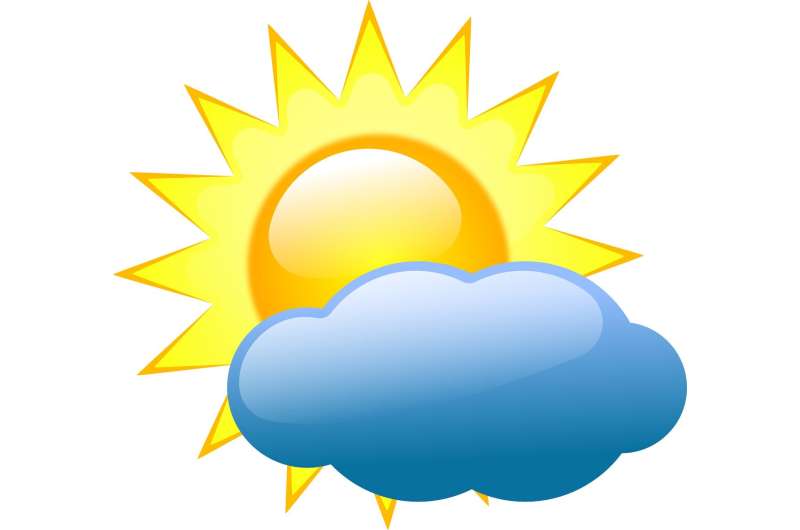This article has been reviewed according to Science X's editorial process and policies. Editors have highlighted the following attributes while ensuring the content's credibility:
fact-checked
trusted source
proofread
Enhancing statistical reliability of weather forecasts with machine learning

A global team of researchers has made strides in refining weather forecasting methods, with a specific focus on addressing the persistent issue of "quantile crossing." This phenomenon disrupts the order of predicted values in weather forecasts and arises from the numerical weather prediction (NWP) process—a two-step forecasting method involving observations and atmospheric evolution laws.
Despite NWP advancements, models still yield biased and under-scattered forecasts. To mitigate this, past attempts explored nonparametric methods like quantile regression neural networks (QRNN) and their variants, designed to output quantiles reflecting value ranks in the forecast distribution. However, these methods often face "quantile crossing," hindering forecast interpretation.
Ad hoc solutions, like naive sorting, didn't address the core issue. Enter the team's breakthrough: the non-crossing quantile regression neural network (NCQRNN) model.
This innovation, developed by Professor Dazhi Yang and his co-workers from the Harbin Institute of Technology, Karlsruhe Institute of Technology, Chinese Academy of Sciences, National University of Singapore, UK Power Networks, China Meteorological Administration, Heilongjiang Meteorological Bureau, and Budapest University of Technology and Economics, tweaks the traditional QRNN structure. The NCQRNN model modifies the structure of the traditional QRNN by adding a new layer that preserves the rank order of output nodes, such that the lower quantiles are constrained to be perpetually smaller than higher ones without losing accuracy.
Their findings are published in Advances in Atmospheric Sciences.
Professor Yang emphasizes, "Our NCQRNN model maintains the natural order of forecast values, ensuring lower quantiles stay smaller than higher ones. This boosts accuracy and significantly improves forecast interpretability."
Dr. Martin J. Mayer from the Budapest University of Technology and Economics adds, "The idea is simple but effective: The neural network indirectly learns the differences between the quantiles as intermediate variables and uses these non-negative values in an additive way for estimating the quantiles, inherently guaranteeing their increasing order."
"Moreover, this non-crossing layer can be added to a wide range of different neural network structures, ensuring the wide applicability of the proposed technique."
Indeed, successfully applied to solar irradiance forecasts, this innovative machine-learning approach showcased substantial improvements over existing models. Its adaptable design allows seamless integration into various weather forecasting systems, promising clearer and more reliable predictions for a range of weather variables.
Dr. Sebastian Lerch from the Karlsruhe Institute of Technology says, "The proposed neural network model for quantile regression is very general and can be applied to other target variables with minimal adaptations. Therefore, the method will also be of interest for other weather and climate applications beyond solar irradiance forecasting."
Dr. Xiang'ao Xia from the Institute of Atmospheric Physics at the Chinese Academy of Sciences concludes, "Machine learning has important application prospects in the field of weather and climate research. This study provides an instructive case study on how to apply advanced machine learning methods to numerical weather prediction models to improve the accuracy of weather forecasts and climate predictions."
The international research team comprises individuals with diverse backgrounds, spanning atmospheric sciences, solar energy, computational statistics, engineering, and data sciences. Notably, certain team members involved in this study have collaborated on a review paper elucidating fundamental concepts and recent advancements in solar power curves.
Published on March 1 in Advances in Atmospheric Sciences, this review paper not only establishes a robust understanding of solar power curve modeling principles but also functions as a bridgehead for atmospheric scientists, connecting their knowledge on radiation to the practical utilization of solar power.
More information: Mengmeng Song et al, Non-crossing Quantile Regression Neural Network as a Calibration Tool for Ensemble Weather Forecasts, Advances in Atmospheric Sciences (2024). DOI: 10.1007/s00376-023-3184-5
Provided by Chinese Academy of Sciences




















